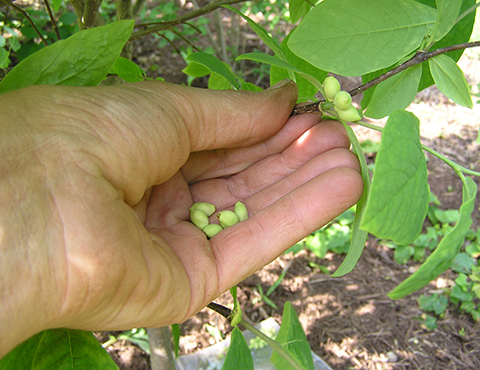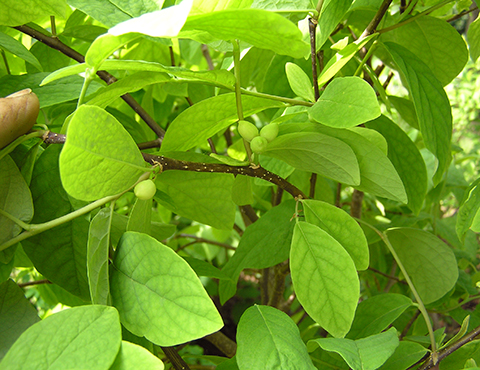 |
| Home | Ordering By Mail | Purchase Manual: Using Native Plants in Urban Landscapes |
|
|||||
Species Name: Dirca palustris
Common Name: Leatherwood
Zone: 4 to 9
Distribution: New Brunswick, southern Quebec south to northern Florida & Louisiana.
Seed collection: Leatherwood blooms very early in the spring from late April to early May in Western NY. Leatherwood blooms before the tree canopy leafs out
and often before most of the spring ephemerals flower. Flowers are small, dull yellow, typically in clusters of three, they are monoecious,
containing both male and female parts. Flowers are produced in abundance on the shrub creating an adequate early spring floral display.
A single fruit develops from each flower so each flower cluster may produce from one to three fruits depending on the level of pollination.
Each fruit contains a single brown seed housed inside a thin fleshy pulp and skin. The fruit are about the size of a pea seed.
The fruit takes approximately1 month from the date of pollination to fully mature. Most seed ripens in late May to early June in western NY.
Immature fruit are light green in color slowly ripening to a light yellow at maturity. The color change is subtle without any additional signs of maturity
so the fruit must be watched closely at this time before the fruit begins to naturally drop.
Begin collecting all of the seed when the first seeds separate easily from the plant when touched. All of the seed will be mature at this time.
Hand collect from the plant or spread a tarp and shake the seed from the plant.
Seed handling: When fully ripe the fruit and skin separate easily from the seed. Hand maceration works best for large batches
or individually remove each seed from its pulp. The seed coat is not very hard and will be damaged if using a food processor that is used
to clean hard coated seed. After collection seed can be sown immediately or moist stratified for planting the following spring.
Germination requirements: Fruits contain a large percentage of sound seed. All information indicates that germination will occur the first spring after planting
but some seed may germinate the following year. Immediate planting after collection is the method that produces the best results
but cold moist stratification and planting in the spring is used as well. Seedlings will require 50% shade the first year to protect the seedlings from the sun.
Ecology: Leatherwood has a large geographic distribution but tends to be restricted to specific localized site conditions within that range.
Where it grows it can be the dominant shrub often being the only understory shrub present. Leatherwood prefers moist mesic soils
in rich hardwood or mixed conifer/hardwood or in wet bottomland forests. On some sites it is often found growing in saturated soils
along seeps and springs and occasionally is found growing in standing water in swamps. It seems to require the dense shade of the understory
where few other plants can compete. Leatherwood grows at a slow rate and large plants may only reach 6 to 7 feet tall.
The degree to which birds eat the fruits has not been well documented or how leatherwood seed is dispersed but it can be assumed
that rodents feed on the fallen seed. Deer show little inclination for browsing the foliage so leatherwood could be a good deer resistant
understory shrub for areas with high deer densities.
Leatherwood has been used on a limited basis for landscaping but it is unclear how well it will do as a landscape plant with full sun exposure.

Leatherwood fruit ready for collecting in early June

Fruit are in clusters of 1 to 3 fruits hiden amongst the foliage. Monitor the seed closely
and collect when a few of the seeds separate from the stem easily.
this page posted February 25, 2015